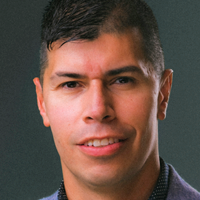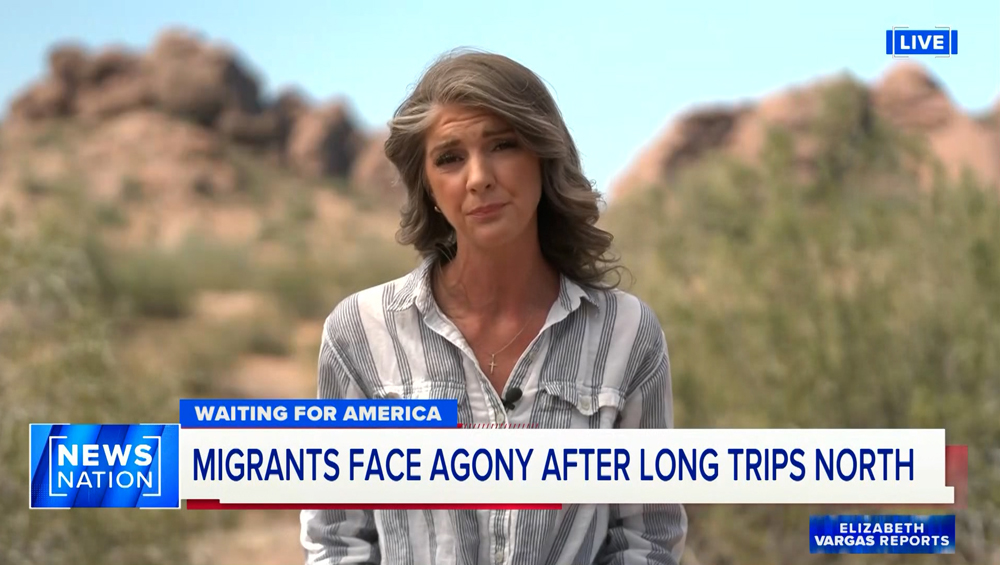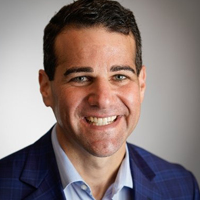
For TV Station Groups, National Collaborations Increase And Improve

A meteorologist discusses a mulch fire at a waste recycling center just outside of Phoenix. A reporter produces a piece about a mom and daughter who’ve grown closer together after a violent tragedy in Buffalo, while another details legal action against three teachers in Missouri who recently quit their jobs.
With more channels to stock with content and, always, a wariness of margins, station groups are increasingly relying on small, focused local stories like these to have outsized reach. Such packages are becoming the backbones of news businesses.
Publishers such as E.W. Scripps, Gray and Nexstar are harnessing the collective power of their individual markets by elevating select segments from within them for broadcast on their national news platforms. In doing so, they get a two-for-the-price-of-one deal out of a piece of content. But they’re also exploiting this bargain behind the scenes with minimal friction between people resources.
Spotting Trends And Solutions

Sybil Hoffman
Over the past couple of years, Gray has launched multiple national news products, including InvestigateTV and the streaming service Local News Live, which use stories from the company’s local markets with potential appeal to national audiences. Still, Sybil Hoffman, executive news director at the group’s Phoenix duopoly, KTVK and KPHO, which has kicked stories up to those national channels, says that on the local level content selection hasn’t changed. What’s different today for local news directors and overseers of national platforms, Hoffman says, is, “There’s a constant collaboration and seizing [of] opportunities when content arises.”
What kinds of local stories work best for nationally focused publishers?
On June 1, when a mulch fire burned about 35 miles east of the KTVK and KPHO headquarters in Phoenix, Hoffman’s morning show team scurried off to a different studio because the air quality in their usual digs had significantly deteriorated. Making lemonade out of lemons, though, Hoffman says the station’s meteorologist, after covering the fire locally, would appear on Local News Live to discuss the atmospheric conditions that fostered such an impactful event — information that could be relevant to other regions that deal with similar issues, perhaps such as Northern California, which now experiences widespread wildfires on a regular basis.
“We’re going to get our meteorologist on that [Local News Live] desk as soon as their show is done and they’re probably going to spend 20 to 30 minutes talking about air quality and the wind and why, especially this morning, it is an issue,” Hoffman says. Cooler temperatures keep such smoke lower to the ground, she explains, and there’s hope that warmer afternoon conditions will release the smoke into the upper air. “So, there’s this background now that we can use on our OTT desk that Local News Live would pick up, but then we also get to stream it.”
When the one-year mark of the mass shooting at a Buffalo supermarket arrived in May, Scripps News leaned its WKBW there for a collection of content. It re-aired the aforementioned story of a mother/daughter pair of survivors, who discussed how their lives have changed and, unfortunately, how concerning issues in the community have not, even in the wake of the tragedy. The national platform also gave a WKBW reporter the chance to do a live shot and lengthy talkback, according to the station’s news director, Aaron Mason.

Aaron Mason
“It’s not like, ‘OK, you have two minutes,’” Mason says, referring to the time parameters of traditional broadcast news shows. “That live shot with the reporter was a nice little talkback that probably went back and forth for a good four or five minutes where my reporter was able to add that local context, to talk about what it’s been like in this community since the shooting happened, what progress has been made [and] what are people saying still needs to be done.”
That kind of opportunity is good exposure for the reporter, Mason says. He agrees, too, that the content the reporter provided might also have motivated local viewers from Buffalo to switch on the national-facing Scripps News.
Over at Nexstar, which, in recent years, has continuously beefed-up news content on its national network, NewsNation, Cherie Grzech, the network’s VP of news and managing editor, says a key to content decisions is discovering trends and solutions to problems.

Southwest correspondent Ali Bradley at the southern border reporting for Nexstar’s NewsNation.
“When an issue is happening across our country, what we’re looking for is one community finding a solution that maybe another community could learn from,” Grzech says. “Is it a transcending issue that maybe every community is dealing with? And maybe one community is a great example of how to deal with that issue better than others.”
That story about the three Missouri teachers who quit their jobs aired on NewsNation, in part because multiple state governments have been taking similar actions against educators whom their respective officials believed violated their contracts.

Lee Zurik
“Local news is more important than ever in terms of keeping an eye on how issues bubble up,” says Lee Zurik, Gray’s VP of investigations, with whom Hoffman frequently discusses story sharing. “We have found it’s important — and impactful — to combine local news station reporters in more than 100 markets along with national reporters who will notice a trend or commonality in problems that affect everyone. For us, this model of working nationally and locally is about informing viewers about disparities in our communities and injustices that are happening in cities and towns across America that may not otherwise get widespread attention.”
While local news directors and their colleagues at national networks and news initiatives put a lot of consideration into what makes for transferable content, with new technologies they hardly have to discuss their potential maneuvers involving the content at all.
Leveraging Technology
Scripps’ Mason applauds the company-wide integration of the planning platform called NewsDesk. Providing a hypothetical, Mason says one of his Buffalo reporters might get assigned a story about the influx of refugees to the area. They’ll write their script, produce their package and upload them both into NewsDesk. An editor at Scripps News, or even a fellow news director in, say, San Diego, who’s curious about what WKBW might’ve reported on the situation can easily review the station’s work and download the script and video for repackaging or re-air elsewhere.
“If they want that video, they don’t even need to reach out to us,” Mason says. “It really is a painless process.”

Sean McLaughlin
Sean McLaughlin, Scripps SVP of local news, says: “We work every day to better connect Scripps News and the journalism done by local stations. This collaboration built around strong journalism allows us to put the quality stories we are producing in front of as many viewers as possible — wherever they are. The technology we use makes this incredibly easy, not just from a sharing perspective, but from a collaboration and story-building concept as well.”
Nexstar uses a similar platform called Daybook, which gives the entire company insight into local-market assignment desk activities.
“We have the ability to look at 199 local stations across America and see what they’re covering, and we may notice a trend before anyone else does,” says NewsNation’s Grzech. “That’s what everybody’s hoping to do.”
Grzech said she and her team can identify in-progress stories from local stations with national potential for re-air on NewsNation before the packages are even finished.
“If we see something of interest, we’re going to go out from our assignment desk level and start making phone calls to see what else we can find out about that story,” she says, including when the segment will be finished and whether they expect to learn any new details that could be of interest to the NewsNation team.
According to Grzech, NewsNation may just re-air a package from a local market or cut up multiple stories from different stations and build out a new trend piece better suited for a national audience.
Over at Gray, James Finch, VP of news services, says the group’s Digital Content Center uses analytics to aggregate the most engaging stories from across its markets. Minor adjustments to the packages may be made to ensure the segments are more relevant elsewhere.
Content sharing is also a two-way street. Zurik sends InvestigateTV stories, investigative reporting with national implications, out to the local markets, too. “Everything is optional,” says Finch. “The stations have autonomy to run whatever they want.”
The same goes for weekly “consumer franchises,” Finch says, programs with titles like Watching Your Wallet, Does it Work?, Make Ends Meet and Did You Know? “The latter three we discovered at the station level and were able to ‘syndicate’ them with little extra effort,” Finch adds.
Reporters in the group’s Washington, D.C., bureau — where Local News Live is based — are also assigned to cover the states where Gray operates. “Stations can request coverage of a legislator and the bureau staff is aggressive with uncovering and reporting on the most pressing issues,” Finch says. “In addition to the reporter beats, we have a national correspondent assigned to the White House who has travelled overseas to cover the POTUS. We have also run a series called Listening to America, which is hot topic-based and features a reporter who travels the nation to hear from Americans.”
Communication Is Key
Hoffman says that when it comes to content sharing, Gray is a well-oiled machine. The various station news directors are constantly in touch with the content managers of the station group’s national broadcast platforms.
“I get weekly emails on their entire list of stories that they’re going to be putting out that week,” Hoffman says, “so that’s disseminated to all the Gray stations [and] you don’t get the sense that InvestigateTV is dictating [content production] on a local front. They’re looking to us just as often as we’re looking to them for good ideas.” She adds that everyone is actively seeking “collaborative opportunities that we can seize that just benefit everybody.”
These avenues of communication are so wide open in part because, across the board, Gray’s employee base has bought into the approach of leveraging all its local markets to contribute to its national assets.
“The idea of getting all of us [to be] part of one company and understanding the mission going forward has been really exciting,” Hoffman says. To help maintain that alignment, she says the station group’s Chairman and CEO Hilton Howell, as well as its COO, Sandy Breland, often turn up at stations to discuss company strategies. “When you see that kind of commitment and face-to-face interaction, it’s huge,” Hoffman says.
Grzech says notifications arrive to NewsNation from stations, alerting the national streamer about important breaking stories, through the Daybook platform as well as email and, yes, even phone calls.
“Every system we build day to day we build out to make sure communication is carried out throughout the network, both on television and all of our digital properties as well, to make sure that it’s distributed and we’re not duplicating our efforts,” she says. “It becomes very productive, and it becomes very informative.”
“Communication is key,” says Scripps’ Mason. “Having the right infrastructure to share resources is key.”
Not only will Scripps News receive alerts through NewsDesk about stories that might work for it, but Mason also says the national outlet is built with smart employees who are keenly aware of coverage needs. Weeks ahead of the one-year marker for the Buffalo-area mass shooting, Mason says Scripps News reached out to him about what they might be working on and how they could collaborate.
If station groups are going to remain sustainable, it’ll take total teamwork.
“What we’ve learned over the years of working with our model is that local stories often have national implications and vice versa,” says Gray’s Zurik. “From small markets to large markets to our national teams, collaboration improves the visibility of stories that matter and puts issues in front of changemakers with the ability to act.”
























Comments (1)
Jim Long says:
June 13, 2023 at 9:51 am
Terrific story and terrific moves by the Station Groups. Eventually, when ATSC-3.0 is widespread, these national channels will be over the air too as will the current growing crop of 24×7 local news channels. Didja expects both to be available sooner via Local TV Streaming as well. All of this helping strengthen local TV.